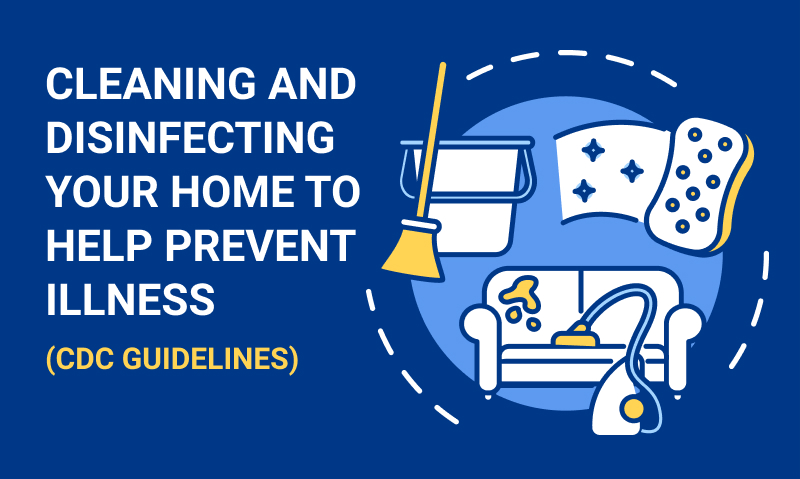Cleaning and Disinfecting Your Home to Help Prevent Illness (CDC Guidelines)

Properly clean and disinfect your home to protect your family from COVID-19
When it comes to protecting yourself and your family from COVID-19, the two most important things you can do is stay at home as much as possible and disinfect it regularly. Based on the behavior of other coronaviruses, experts believe the strain that causes COVID-19 can likely survive on surfaces for anywhere between a few hours to several days, depending on the environment and type of surface. As a result, cleaning and disinfecting your home properly in a way that kills as many germs as possible without contaminating other surfaces or exposing yourself to the illness is essential to keeping yourself and your family healthy. Thankfully, the CDC has released incredibly helpful guidelines on how to disinfect your home, which we’ll break down for you below.
The Difference Between Cleaning and Disinfecting
According to the CDC, cleaning doesn’t kill germs but instead removes germs and dirt from surfaces, which reduces the chance of spreading infection. Disinfecting a surface involves chemicals that kill germs without removing them from the surface. Using these two methods together has the best chance of protecting you from infection, so you should first clean a surface with soapy water, dry it, and then disinfect it. Additionally, always wear disposable gloves to limit your exposure to the germs on the surface you’re cleaning and disinfecting.
Disinfecting a Hard Surface
You should clean and disinfect surfaces, especially those that are used regularly by multiple people in the house, every day—even when they don’t appear dirty. This includes items like countertops, doorknobs, light switches, faucets, and tables. The CDC recommends using an EPA-registered disinfectant and following its directions closely when you use the product, but not all disinfectants are safe for surfaces like natural stone countertops.
In this case, you can instead use a solution of at least 70% alcohol or diluted bleach, which should contain five tablespoons of bleach per gallon of water. If you opt to create a diluted bleach solution, make sure the type of bleach you’re using is approved for disinfection and never mix it with an ammonia-based cleaner or any other type of household cleaner. Bleach creates potentially harmful fumes, so always ensure proper ventilation when you’re cleaning with it, and let the solution sit on the surface you’re disinfecting for at least a minute.
Sterilizing Electronic Devices
Ideally, electronic devices should also be cleaned daily, especially common-use devices, like remotes and devices, and your phone, which leaves your home with you. It’s a good idea to clean keyboards, tablets, and handheld gaming devices daily as well. To avoid damaging your electronics, follow the manufacturer’s directions for cleaning and disinfecting it. If you can’t find any directions, use alcohol wipes or sprays that contain at least 70% alcohol to clean the device, making sure to dry it thoroughly to prevent moisture damage.

Sanitizing Laundry
For the most part, you can wash laundry items, such as clothing, towels, and bedsheets, as you normally would—with a few additions. Follow the care instructions printed on the item’s tag, but bring the water in the washer up to the warmest you can for that item. Never shake laundry, as this can disperse germs on the clothing into the air, and clean and disinfect laundry hampers before you put clean clothes back into them. If there’s a chance that the coronavirus is present on clothing, either due to someone in your household being an essential worker or showing symptoms of the virus, always wear disposable gloves when you handle their laundry.
Cleaning Carpets and Other Soft Surfaces
Unless someone in your household is sick, you don’t have to clean and disinfect fabrics and other soft surfaces, such as carpets, drapes, and pillows as often as other surfaces. When you clean soft surfaces, you should also follow the model of cleaning the material before disinfecting it. This often means using a household cleaner designed for that type of material, then following the care instructions on the label to disinfect it; if possible, put it in the washing machine or hand-wash it with water as warm as you can get it, then dry the material thoroughly by either hang drying it or putting it in the dryer.
Avoiding Contamination From Someone Sick With COVID-19
If someone in your household has tested positive for COVID-19, separate them from everyone else as much as possible. Encourage them to stay in a separate bedroom and, if possible, have a bathroom and trash can entirely to themselves. While you should amp up your cleaning and disinfecting of other surfaces in the house, only clean the area that the sick person is staying in when it’s absolutely necessary; this prevents you from taking the risk of being exposed to the disease unnecessarily. Bring meals to the sick person in their room, ensuring they eat separately, and handle their laundry, trash, used dishes, and anything else they touch regularly with disposable gloves instead of your bare hands. After removing the gloves, throw them away—never reuse them—and wash your hands thoroughly for 20 seconds.
Although COVID-19 has been making world news with how far it has spread and the damage it has done, it’s not invincible. If you arm yourself with the right tools and the knowledge of how to use them, you can clean and disinfect your home regularly, which will go a long way toward protecting you and your family from COVID-19.